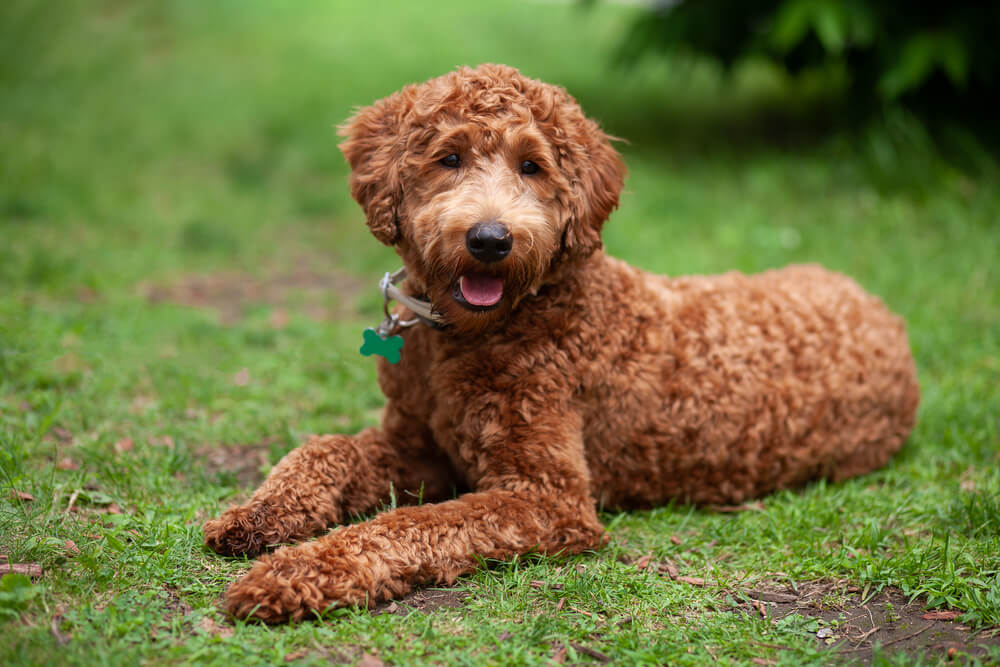Labradoodle Dog Breed: Size, Personality and More

DogFoodAdvisor is reader supported See how
All reviews are 100% impartial but if you buy using links on this page, we may earn a referral fee.
The Labradoodle is a hybrid dog breed, resulting from a cross between a Labrador Retriever and a Poodle.
They were originally bred in Australia in the late 1980s by Wally Conron, who worked for the Royal Guide Dog Association of Australia. The goal was to create a guide dog that combined the intelligence and trainability of the Labrador Retriever with the hypoallergenic coat of the Poodle to assist people with allergies.
Since then, Labradoodles have gained immense popularity worldwide as companion animals, known for their friendly temperament, intelligence, and low-shedding coat. They are now commonly bred as both family pets and service dogs, although they are not officially recognized as a distinct breed by major kennel clubs.
Labradoodles have become one of the most popular designer breeds in the United States, especially among families with children and those with allergy concerns.
They are frequently chosen as therapy or service dogs due to their trainability.
General Characteristics:
- Origin: Australia
- Size: Labradoodles come in three size categories – Standard, Medium, Miniature which depend on the size of the Poodle parent
- Height: Standard, 21–24 inches tall at the shoulder; Medium, 17–20 inches tall; Miniature, 14–16 inches.
- Weight: Standard, typically weighs 50–65 pounds; Medium, weighs 30–45 pounds; Miniature, weighs 15–25 pounds
Appearance:
Labradoodles often have a sturdy build, floppy ears, and a friendly expression.
- Coat: Ranges from curly (Poodle-like) to wavy or straight (Labrador-like). Coat types vary in shedding levels, with curlier coats being more hypoallergenic
- Colors: Common coat colors include cream, gold, chocolate, black, and apricot
Labradoodle Temperament:
- Friendly Nature: Known for their social, affectionate, and loving demeanor, making them excellent family pets.
- Intelligence: They inherit intelligence from both parent breeds, making them quick learners and easily trainable.
- Playfulness: Active and energetic, Labradoodles thrive in environments where they can engage in physical activities like walking, running, or swimming.
- Adaptability: They are versatile dogs that can suit various lifestyles, from active families to singles and seniors.
Training and Exercising:
- Training: Labradoodles are generally easy to train, thanks to their intelligence, eagerness to please, and strong work ethic, which they inherit from both parent breeds—the Labrador Retriever and the Poodle. These qualities make Labradoodles highly responsive to training, whether for basic obedience, advanced tricks, or specialized tasks like therapy work.
- Exercise: Labradoodles are active and energetic dogs that thrive on regular physical and mental exercise. Adult Labradoodles need between 60–90 minutes per day; puppies, around five minutes of exercise per month of age, up to twice a day (e.g., a three-month-old puppy needs 15 minutes per session.)
Grooming:
- Shedding: First-generation Labradoodles (F1: Labrador x Poodle) may shed more unpredictably because their coat type varies widely. Multi-generational Labradoodles (bred from Labradoodles over several generations) are more likely to have consistent low-shedding coats.
- Grooming: Regular grooming and brushing can reduce shedding and prevent matting, regardless of coat type.
Interesting Facts:
- While Labradoodles are often marketed as hypoallergenic, not all individuals have non-shedding or allergy-friendly coats. This depends on their genetics and coat type (fleece, wool, or hair).
- Labradoodles inherit webbed feet from their Labrador Retriever lineage, making them excellent swimmers.
- Labradoodles gained widespread popularity after Oprah Winfrey revealed her love for the breed, calling them “the best dogs.” Their charm and versatility have made them a favorite among families worldwide.
- Other celebrities who are fans of this breed include: Jennifer Aniston – the actress has a Labradoodle named Clyde; Tiger Woods – the famous golfer owns two Labradoodles, Taz and Bugs.
- Labradoodles’ coats can change color slightly as they age, often lightening or darkening over time.
Labradoodle Price:
The average cost of a Labradoodle in the U.S. varies depending on the dog’s pedigree, the breeder’s reputation, location, and whether the dog is intended for show, breeding, or as a pet. Here’s a general guide:
General Price Range:
Labradoodle puppies typically cost between $1,500 and $3,000 when purchased from reputable breeders.
Rescue or Adoption:
Adoption Fees: Adopting a Labradoodle from a rescue organization or shelter is generally more affordable, with fees ranging from $100 to $500.
The Best Food for Labradoodles
Taste of the Wild High Prairie
This is a great choice for Labradoodles because it provides high-quality, grain-free nutrition with novel proteins like bison and venison, supporting their active lifestyle and lean muscle development. Its blend of probiotics, antioxidants, and omega fatty acids promotes healthy digestion, immune function, and a shiny coat.
For more choices: See our Best Food for Labradoodles page.
Final word
The Dog Food Advisor does not accept money, gifts, samples or other incentives in exchange for special consideration in preparing our reviews.
However, we do receive a referral fee from online retailers (like Chewy or Amazon) and from sellers of perishable pet food when readers click over to their websites from ours. This helps cover the cost of operation of our free blog. Thanks for your support.
For more information, please visit our Disclaimer and Disclosure page.



